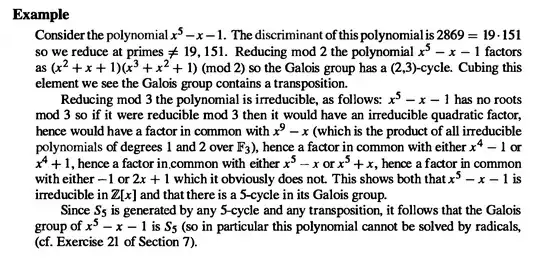My question regards a very specific part of an example in Chapter 14.8 of Dummit and Foote (page 641, image shown below) in which the authors are computing the Galois group of $f(x) = x^5 - x - 1$ over $\mathbb Q$. They want to prove $f(x)$ is irreducible modulo 3 in order to show the Galois group over $\mathbb Q$ contains a $5$-cycle. To rule out a factorization consisting of an irreducible quadratic and a cubic, they provide the following justification:
[If $f(x)$ had an irreducible quadratic factor modulo 3 then] it would have a factor in common with $x^9 - x$ (which is the product of all irreducible polynomials of degrees 1 and 2 over $\mathbb F_3$), hence a factor in common with either $x^4 - 1$ or $x^4 + 1$, hence a factor in common with either $x^5 - x$ or $x^5 + x$, hence a factor in common with either $-1$ or $2x + 1$.
I understand this reasoning up until the final phrase. Why does sharing a factor with $x^5 - x$ or $x^5 + x$ modulo $3$ imply sharing a factor with $-1$ or $2x - 1$?
A more general question regarding this example was asked here, but it was never answered and is less specific.
